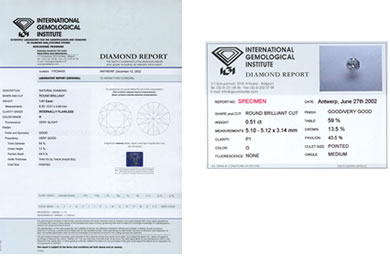

Their Antwerp lab was among the first in Europe, their grading and schooling in India is perceived as first-class. Outside the USA IGI's reports are considered quite reputable. If they did, I wager their reputation would improve. They are not serving the USA's independent or high-street jewelry community with abundant loose-diamond grading reports. Additionally, IGI's main presence here is the grading of goods from foreign mass-producers which find their way to department-store counters. These reports include a replacement-value (for insurance) which is arguable and has the potential for abuse by salespeople in those stores. The main player is a "finished jewelry appraisal-report" designed for pieces sold by a number of chain stores. Why the negative sentiment about IGI in the USA? It is attributable to a subset of reports proliferated by their New York location only.

In terms of range and reach they are outpacing their USA peers in this area. They are producing Jewelry Designers and CAD operators across 14 schools in locations from Antwerp to Shanghai. This includes coursework more diverse and modern than the typical USA Graduate-Gemologist track. IGI's schools of gemology in China and India serve thousands of jewelry professionals with top-tier education which has helped the Asia-Pacific trade grow responsibly. In terms of gemological education they are the industry leader in depth and scope of curriculum. With that said, IGI is a remarkable global organization employing a lot of good, honest people. So, for anyone with any doubts, there's no reason to swerve elsewhere. To be clear: Let me first agree that anyone shopping in the USA can find abundant options graded by GIA or AGS. I'm replying because the title of this thread will bring it up in future searches, and the IGI story is more broad than the sharp indictments posted above. When they fail to do that accurately, it gives us no confidence or assurance the price we are paying for that stone is truly good or not.

They aren't.īut at the end of the day, the lab reports we get are supposed to give us confidence on the properties of the diamond we are buying. This isn't to say that GIA is the holy grail and perfect.
#Igi certificates how to
The problem I have is that because the certification is untrustworthy I don't know how to accurately gauge the price. Jumping back to our real world here, I'm not advocating that an IGI stone can't be gorgeous and acceptable.

Obviously the 10% savings wasn't a savings at all. Not to mention the $200-300 you spent getting the stone graded to GIA standards. You nearly pop a blood vessel because you see a 1 carat G SI1 is selling $950 cheaper than what you paid. You look at the jeweler's website where you bought your IGI stone and see a 1ct G SI1 for $5,800. You decide to spend the time and money to have your stone re-graded. Then you go home, find Pricescope and discover IGI isn't reliable. After all, under jeweler lighting they both look great. If you didn't know better, it would seem like a good deal getting an IGI graded F VS1 stone for $6,750 as opposed to $7,500 for a GIA graded stone of the same characteristics. 1ct G SI1 GIA graded = $5,800 per carat.1ct F VS1 GIA graded = $7,500 per carat.Whatever the percentage, the more worrisome part is the not being able to trust the cert and the dollars you may lose as a result of the grading variances.įor example (all fictitious data used to prove my point): Hey where are you getting the data on the 10% difference from? Not disputing, just I've never done an analysis and was curious your source. Ask our PriceScope members and industry experts for a second opinion or get lost in the thousands of user-shared diamond and jewelry images for inspiration.


 0 kommentar(er)
0 kommentar(er)
